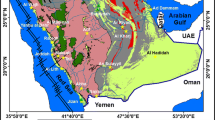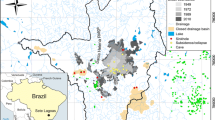Abstract
Evaporite karst in Great Britain has formed in Permian and Triassic gypsum, and in Triassic salt. Active dissolution of these deposits can occur on a human rather than a geological timescale causing subsidence and building damage. The British Geological Survey has taken two approaches towards understanding and advising on hazards caused by dissolution of these soluble rocks. At a detailed level, a national database and GIS of karstic features is being populated. Information gathered includes dolines, springs, stream sinks, caves and building damage. At a national level, the soluble rocks in Great Britain have been identified and digital-map polygon information relating to them was extracted from the British 1:50,000-scale digital geological map. These areas have been assessed, and in places their margins extended to include some overlying rocks where subsidence features are known to penetrate upwards through the overlying sequence. The national areas have then been assessed using detailed local information to assign a susceptibility rating from A (extremely low) to E (high), depending on the nature and regularity of the subsidence events that occur. This national zonation of the soluble rocks can be used for planning, construction and in the insurance businesses. This has proved useful for assessing the potential stability of linear routes, such as roads and pipelines or for other important structures such as bridges and buildings. The information can also be used to delineate zones of karstic groundwater flow.





Similar content being viewed by others
References
Applied Geology Limited (1993) Review of instability due to natural underground cavities in Great Britain. Royal Leamington Spa, Applied Geology Ltd
Arup Geotechnics (1990) Review of mining instability in Great Britain, Stafford brine pumping. Arup Geotechnics for the Department of the Environment, vol 3/vi
Calvert AF (1915) Salt in Cheshire. Spon Ltd, London, 1206 pp
Collins JFN (1971) Salt: a policy for the control of salt extraction in Cheshire. Cheshire County Council
Cooper AH (1986) Foundered strata and subsidence resulting from the dissolution of Permian gypsum in the Ripon and Bedale areas, North Yorkshire. In: Harwood GM, Smith DB (eds) The English Zechstein and related topics. Geological Society of London, Special Publication, vol 22, pp 127–139
Cooper AH (1988) Subsidence resulting from the dissolution of Permian gypsum in the Ripon area; its relevance to mining and water abstraction. In: Bell FG, Culshaw MG, Cripps JC, Lovell MA (eds) Engineering geology of underground movements. Geological Society of London, Engineering Geology Special Publication, vol 5, pp 387–390
Cooper AH (1989) Airborne multispectral scanning of subsidence caused by Permian gypsum dissolution at Ripon, North Yorkshire. Q J Eng Geol Lond 22:219–229
Cooper AH (1998) Subsidence hazards caused by the dissolution of Permian gypsum in England: geology, investigation and remediation. In: Maund JG, Eddleston M (eds) Geohazards in engineering geology. Geological Society, London, Engineering Special Publications, vol 15, pp 265–275
Cooper AH (2002) Halite karst geohazards (natural and man-made) in the United Kingdom. Environ Geol 42:505–512
Cooper AH, Calow R (1998) Avoiding gypsum geohazards: guidance for planning and construction. British Geological Survey Technical Report WC/98/5. Available on the Internet at: http://www.bgs.ac.uk/dfid-kar-geoscience/database/reports/colour/WC98005_COL.pdf
Cooper AH, Saunders JM (2002) Road and bridge construction across gypsum karst in England. Eng Geol 65:217–223
Cooper AH, Farrant AR, Adlam KAM, Walsby JC (2001) The development of a national geographic information system (GIS) for British karst geohazards and risk assessment. In: Beck BF, Herring JG (eds) Geotechnical and environmental applications of karst geology and hydrogeology. Proceedings of the 8th multidisciplinary conference on sinkholes and the engineering and environmental impacts of Karst, April 1–4 2001, Louisville, Kentucky, USA. Balkema, Amsterdam, pp 125–130
Department of the Environment (1990) Planning policy guidance note 14: Development on unstable land. HMSO, London
Department of Transport, Local Government and the Regions (2002) Planning policy guidance note 14. Development on unstable land. Annex2: Subsidence and planning. http://www.planning.detr.gov.uk/conindex.htm
Gibson AD, Forster A, Culshaw MG, Cooper AH, Farrant, AR, Jackson, N, Willet D (2006) Rapid geohazard assessment system for the UK natural gas pipeline network. In: Proceedings of the international symposium on geology and linear developments—Geoline 2005, Lyon. 23rd–25th May 2005. Digital Proceedings ISBN 2–7159–2982-x***
Griffin DA (1986) Geotechnical assessment of subsidence in and around Ripon, North Yorkshire, due to natural solution. Master Thesis, University of Newcastle upon Tyne, 85 pp (Unpublished)
Gutiérrez F, Cooper AH (2002) Evaporite dissolution subsidence in the historical city of Calatayud, Spain: damage appraisal, mitigation and prevention. Nat Hazards 25:259–288
Hucka VJ, Blair CK, Kimball EP (1986) Mine subsidence effects on a pressurized natural gas pipeline. Mining Eng 38:980–984
Klimchouk A, Lowe D, Cooper A, Sauro U (eds) (1997) Gypsum karst of the world. Int J Speleol 5 (3–4) for 1996, 307 pp
Jones CJFP, Cooper AH (2005) Road construction over voids caused by active gypsum dissolution, with an example from Ripon, North Yorkshire, England. Environ Geol 48:384–394
McNerney P (2000) The extent of subsidence caused by the dissolution of gypsum in Ripon, North Yorkshire. BSc Thesis, University of Leeds (unpublished)
NCB (1975) Subsidence Engineers’ Handbook. National Coal Board Mining Department. UK, 111 pp
Paukštys B, Cooper AH, Arustiene J (1997) Planning for gypsum geohazards in Lithuania and England. In: Beck FB, Stephenson JB (eds) The Engineering Geology and Hydrogeology of Karst Terranes. Proceedings of the 6th multidisciplinary conference on sinkholes and the engineering and environmental impacts of Karst Springfield/Missouri/6–9 April 1997. AA Balkema, Rotterdam, pp 127–135
Ryder PF, Cooper AH (1993) A cave system in Permian gypsum at Houtsay Quarry, Newbiggin, Cumbria, England. Cave Sci 20:23–28
Seedhouse RL, Sanders RL (1993) Investigations for cooling tower foundations in Mercia Mudstone at Ratcliffe-on-Soar, Nottinghamshire. In: Cripps JC, Coulthard JC, Culshaw MG, Forster A, Hencher SR, Moon C (eds) The Engineering geology of weak rock. Proceedings of the 26th annual conference of the Engineering Group of the Geological Society, Leeds, 1990. AA Balkema, Rotterdam, pp 465–471
Thomson A, Hine PD, Greig JR, Peach DW (1996) Assessment of subsidence arising from gypsum dissolution: Technical Report for the Department of the Environment. Symonds Group Ltd, East Grinstead, 228 pp
West IM (1964) Evaporite diagenesis in the Lower Purbeck Beds of Dorset. Proc Yorks Geol Soc 34:315–330
Acknowledgments
This work has benefited from discussions and help from numerous colleagues, especially Professor Martin Culshaw, Dr Francisco Gutiérrez, Keith Adlam, Al Forster, Dr Andy Gibson, Dr Andy Farrant, Matt Harrison, Dave Bridge, Jenny Walsby, Rhonda Newsham and Kathrine Linley. The karst database has been largely populated by Dr Andy Farrant, Sarah Doran, Nathan Williams, Amanda Richardson and the author. Published with permission of the Executive Director, British Geological Survey (NERC).
Author information
Authors and Affiliations
Corresponding author
Rights and permissions
About this article
Cite this article
Cooper, A.H. The GIS approach to evaporite-karst geohazards in Great Britain. Environ Geol 53, 981–992 (2008). https://doi.org/10.1007/s00254-007-0724-8
Received:
Accepted:
Published:
Issue Date:
DOI: https://doi.org/10.1007/s00254-007-0724-8




